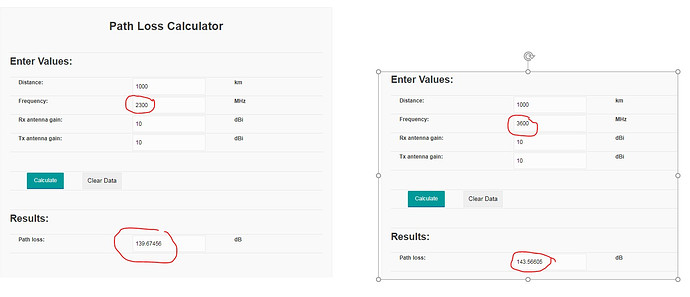Sorry. I am talking about comparison of RSRP at 2.3G LTE and 3.5G NR.
This I do not know. 
Like 3.5G NR RSRP is how much dB lesser than 2.3G LTE RSRP at location, if both cells are co-located?
This is only reason i am looking for nR link budget for NR.
But how can we compare, it’s about tilts, power, antenna gain of SSBs.
I think it is possible to compare only for DSS.
4G anchor with 5G DSS.
Lets assume everything is same.
My assumption is that, considering beam forming gain in NR, NR will have almost same or slightly higher RSRP that colocated (with same antenna parameters , power) 2.3G LTE RSRP.
If we use same parameters there’s a loss of about 4 dB at 1000 meters distance:
You can paly around here:
Is beam forming gain being considered here?
But do you have it in LTE?
Is there AAU for LTE?
Or just classic 4T4R antenna?
Beamforming gain is about 27 dBi or 30-33 depends on number of antennas.
You said we need to consider same parameters for 4G and 5G. 
We can’t calculate beamforming gain, it’s R&D controlled.
It depends on number of CSI-rs ports.
Beam forming gain I am talking is only for NR, not LTE.
That’s why I am assuming NR will have more RSRP if all other parameters are same.
OK, Link Budget is always uplink limited in both 4G and 5G.
What we have seen in drive test is that without dynamic power sharing a 23 dBm UE will use max 20 dBm for LTE and max 20 dBm for 5G.
Like this both LTE and 5G will get a more limited Link Budget compared to only LTE Link Budget.
Yes, but UL can selection rules.
We can configure UL as LTE only.
Yes, but you still need PUCCH in 5G.
So there will still be 5G UL.
With less time compared to PUSCH.
Indeed,
But PMI, CQI and RI are needed in Uplink.
If they are periodic, they will be carrier by PUCCH only.
Aperioidic will require PUSCH.
Adding extra info:
Cell selection and cell reselection in Rel.8
For evaluation of conditions used for cell selection and cell reselection processes UE terminals Rel.8 use only RSRP based measurements of LTE cells.
Cell selection and cell reselection in Rel.9
According 3GPP, UE terminals Rel.9 are obliged to make RSRP and RSRQ based measurements and use them for cell selection and cell reselection procedures.
All Rel.9 and higher compliant UE terminals shall support RSRQ measurements in IDLE mode.
RSRQ for measurements of LTE serving cell as well as neighbor intra-frequency and inter-frequency LTE cells.
In Rel.9 SI (System Information) extended to include RSRQ information.
There is no restriction from standard point of view, i.e. we can use RSRP and RSRQ both for cell selection and reselection.
If RSRQ based measurement in idle mode are not enabled (Q_QUAL_MIN not configured to UE)
- Cell selection reselection is purely based on RSRP
If RSRQ based measurement in idle mode are enabled (Q_QUAL_MIN and other Q parameters configured to UE)
-
For cell cell selection, both RSRP and RSRQ conditions should be satisfied for the candidate cell
-
Intra frequency measurement are only started when serving cell do not satisy either RSRP or RSRQ condition (sIntraSearch p/q)
-
Inter freqncy measurement are only started when serving cell do not satisy either RSRP or RSRQ condition (sNonIntraSearch p/q)
-
Neighbor cells with higher reselection priority than serving cells are always measured irresepctive of serving cells RSRP/RSRQ
-
Reselection to higher priority inter frequency cell is only happen when higher prioirty cells satisfied RSRQ th. (ThreshXHighq)
-
Reselection to lower priority inter frequency cell is only happen when serving cells RSRQ is less that threshold (Thresh Serving lowq) and nbr cells RSRQ is higher than th (ThershXLowQ)
Important - All intra frequency reselections are always based on RSRP, even though we enable RSRQ based idle mode measurement.
Now, why I said that RSRQ based measurement is not supported in LTE is bacuse of my information from Samsung system.
Samsung do not allow to configure Q_QUAL_MIN in LTE.
Reason why this is because, RSRQ measurement is idle mode are not accurate as compare to RSRP. Also, RSRQ is highly dependent on current traffic in network, overlapping, etc.
So we cannot stop user from camping on network, just because RSRQ is poor at that location.
I’m confused with the units of distance, 1000 km? is this 1,000,000 m?
